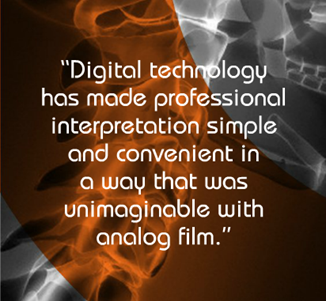 Dr. Chad Warshal is a Doctor of Chiropractic and Diplomate of the American Chiropractic Board of Radiology and teaches as an Associate Professor at New York Chiropractic College where he also serves as the Director in Diagnostic Imaging Residency. We sat down with him for our most recent edition of an Inside Look magazine to hear his views on the current role of diagnostic imaging within the Chiropractic field.
Dr. Chad Warshal is a Doctor of Chiropractic and Diplomate of the American Chiropractic Board of Radiology and teaches as an Associate Professor at New York Chiropractic College where he also serves as the Director in Diagnostic Imaging Residency. We sat down with him for our most recent edition of an Inside Look magazine to hear his views on the current role of diagnostic imaging within the Chiropractic field.
1. Let’s start by asking you about the continuing focus on evidence-based practice guidelines. Do you see this having an effect on the use of diagnostic imaging by chiropractors to aid in clinical decision-making?
The continued evolution of evidence-based practice has had a significant effect on the use of imaging procedures in chiropractic. With most research demonstrating the limited utility of conventional radiography in spinal pain patients, I’ve seen a general decrease in taking radiographs, as well as fewer requests for advanced imaging modalities. The positive side of this is that with greater use of ‘red flag’ based guidelines, there are fewer ‘normal’ studies. I’ve found that using clinical decision tools has resulted in more studies with findings that affect the prognosis or management of the patient.
2. Chiropractors have several ways they can integrate imaging into their care plans – including referring the patient to an imaging center or offering onsite exams. Do you expect to see more practices bringing imaging in-house?
The trend demonstrated by the NBCE Practice Analysis shows a shift toward fewer chiropractors that own radiographic equipment in favor of referring patients to imaging centers. There are multiple reasons for this shift, such as the ability to refer to an imaging center for high-quality imaging, digital access to imaging via online portals, and the professional interpretation of a radiologist. Other reasons include the overhead costs of in-house imaging, the increasingly stringent quality-assurance/quality-control procedures required and decreasing reimbursements.
3. Many practices that offer onsite imaging use film. What advantages does digital imaging bring to practices?
Having worked in radiology when film was the only option, it’s easy to sing the praises of digital radiographs over film. With film, the only options you have for changing how it looks after the exposure is to use a brighter viewbox or a hot light. Of all the benefits of digital, I believe the greatest is the ability to manipulate the contrast and brightness of the images. Add to that the decrease in patient radiation exposure due to retakes, space savings from records storage, and the long-term cost savings of digital over film, and it makes the conversion to digital a fantastic choice.
 4. Do chiropractors tend to read their own X-rays, or are the images sent to a radiologist and a report provided to the chiropractor?
4. Do chiropractors tend to read their own X-rays, or are the images sent to a radiologist and a report provided to the chiropractor?
The answer to that question is twofold. First, chiropractors receive intensive education in the interpretation of musculoskeletal radiographs. Because of that education, there is a certain degree of comfort in reading their own studies. However, one of the important points stressed in chiropractic education is the use of specialists. I had a diagnostic-imaging consultation practice before moving to academia, and I still maintain an imaging-consultation practice with New York Chiropractic College. I’ve noticed there are two major patterns when chiropractors refer studies for interpretation.
The first (and most common situation) is doctors of chiropractic who read their own films, but refer the problem cases or those with questionable findings to the radiologist for interpretation. The second scenario involves doctors who prefer to have all their imaging read by radiologists. This tends to be seen more with large medical-legal practices.
5. There’s a perception that when an X-ray exam is needed, it’s usually best to have the exam interpreted by a radiologist and then have the report made available to your chiropractor. How has digital technology changed this?
Digital technology has made professional interpretation simple and convenient in a way that was unimaginable with analog film. If a field practitioner wants an interpretation on film-based images, the films have to be delivered or shipped to the radiologist, leading to a substantial lag in diagnostic evaluation. And there’s always the concern of films being lost or damaged in the mail. With the continued expansion of digital imaging, this allows essentially one-button pushing of images to a radiologist, even allowing reads from 3,000 miles away, two minutes after the images are taken. The interpretation is quick, there’s no chances of lost studies in the mail, and there are cost saving – not only in terms of postage, but also in terms of less staff time packaging and refilling films.
6. You head the radiology residency at New York Chiropractic College. Are you seeing interest grow in chiropractic imaging? What’s driving your students to choose this path?
Chiropractors have always had a strong interest in imaging. Over the years, that has evolved along with radiology, as we discover more about what imaging is – and is not – good for. The people who enter the postgraduate diagnostic imaging residency programs are those who have a strong academic talent, a good eye for interpretation, and have discovered a passion about the diagnostic aspect of health care.
Chiropractic and Diagnostic Imaging: Evolving Trends [INTERVIEW]










